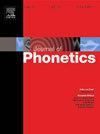Processing pronunciation variation with independently mappable allophones
IF 2.4
1区 文学
0 LANGUAGE & LINGUISTICS
引用次数: 0
Abstract
Sound change can present synchronic variation with categorical pronunciation variants. This is the case in Cantonese, where syllable-initial /n/ is merging with /l/, occasionally creating homophones (e.g., lou5 腦 “brain”/ 老“old”) and giving rise to [n]- and [l]-initial pronunciation variants that are allophones. This pronunciation variation offers insight into how variation is processed in spoken word recognition because [n] and [l] in Cantonese are not associated with an orthographic standard. Across four experiments, we examine the perception, recognition, and encoding of Cantonese [n] and [l], and use Bayesian analyses where gradient interpretations are more straightforward. We observe perceptual evidence that these allophones are distinguishable (Exp 2). In recognition (Exp 1) and encoding (Exp 3) paradigms, we find that the [n] and [l] allophones are processed neither equivalently nor distinctly when the targets bear the more common [l]-initial allophone. When the targets bear the [n]-initial allophone (Exp 4), we observe high error rates, and somewhat contradictory results. Altogether, the results suggest that [n] and [l] are allophonic variants independently mapped to a phoneme, with connection strengths varying as a function of the frequency, such that the more common [l]-initial pronunciation demonstrates an overall recognition advantage.
用可独立映射的音素处理语音变化
语音变化可以表现为同时性的发音变化。在广东话中就是这种情况,音节开头的/n/与/l/合并,偶尔会产生同音异义字(例如,“脑”/“老”),并产生[n]-和[l]-开头的发音变体,即音素。由于广东话中的[n]和[l]与正字法标准没有关联,因此这种发音变化可以深入了解口语单词识别中的变化是如何处理的。在四个实验中,我们研究了粤语的感知、识别和编码[n]和[l],并使用贝叶斯分析,其中梯度解释更直接。我们观察到这些音素是可区分的(经验2)。在识别(经验1)和编码(经验3)范式中,我们发现当目标使用更常见的[l]-初始音素时,[n]和[l]音素的加工既不等同也不明显。当目标具有[n]-初始音素(Exp 4)时,我们观察到高错误率,并且结果有些矛盾。综上所述,结果表明[n]和[l]是独立映射到音素的音素变体,其连接强度随频率而变化,因此更常见的[l]-初始发音显示出整体识别优势。
本文章由计算机程序翻译,如有差异,请以英文原文为准。
求助全文
约1分钟内获得全文
求助全文
来源期刊

Journal of Phonetics
Multiple-
CiteScore
3.50
自引率
26.30%
发文量
49
期刊介绍:
The Journal of Phonetics publishes papers of an experimental or theoretical nature that deal with phonetic aspects of language and linguistic communication processes. Papers dealing with technological and/or pathological topics, or papers of an interdisciplinary nature are also suitable, provided that linguistic-phonetic principles underlie the work reported. Regular articles, review articles, and letters to the editor are published. Themed issues are also published, devoted entirely to a specific subject of interest within the field of phonetics.
 求助内容:
求助内容: 应助结果提醒方式:
应助结果提醒方式:


